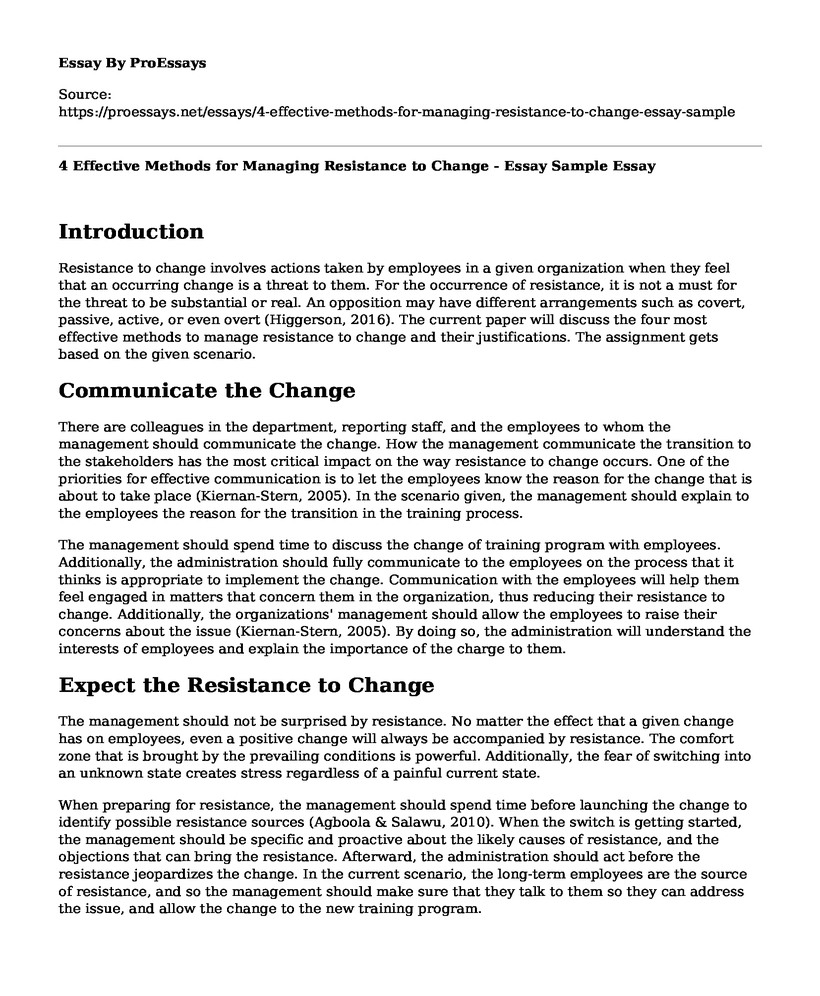Introduction
Resistance to change involves actions taken by employees in a given organization when they feel that an occurring change is a threat to them. For the occurrence of resistance, it is not a must for the threat to be substantial or real. An opposition may have different arrangements such as covert, passive, active, or even overt (Higgerson, 2016). The current paper will discuss the four most effective methods to manage resistance to change and their justifications. The assignment gets based on the given scenario.
Communicate the Change
There are colleagues in the department, reporting staff, and the employees to whom the management should communicate the change. How the management communicate the transition to the stakeholders has the most critical impact on the way resistance to change occurs. One of the priorities for effective communication is to let the employees know the reason for the change that is about to take place (Kiernan-Stern, 2005). In the scenario given, the management should explain to the employees the reason for the transition in the training process.
The management should spend time to discuss the change of training program with employees. Additionally, the administration should fully communicate to the employees on the process that it thinks is appropriate to implement the change. Communication with the employees will help them feel engaged in matters that concern them in the organization, thus reducing their resistance to change. Additionally, the organizations' management should allow the employees to raise their concerns about the issue (Kiernan-Stern, 2005). By doing so, the administration will understand the interests of employees and explain the importance of the charge to them.
Expect the Resistance to Change
The management should not be surprised by resistance. No matter the effect that a given change has on employees, even a positive change will always be accompanied by resistance. The comfort zone that is brought by the prevailing conditions is powerful. Additionally, the fear of switching into an unknown state creates stress regardless of a painful current state.
When preparing for resistance, the management should spend time before launching the change to identify possible resistance sources (Agboola & Salawu, 2010). When the switch is getting started, the management should be specific and proactive about the likely causes of resistance, and the objections that can bring the resistance. Afterward, the administration should act before the resistance jeopardizes the change. In the current scenario, the long-term employees are the source of resistance, and so the management should make sure that they talk to them so they can address the issue, and allow the change to the new training program.
Identify the Cause of Resistance to Change
Focusing on symptoms is ineffective in the management of resistance. For effective resistance management, the administration should have a more in-depth insight into the causes of the opposition (Higgerson, 2016). The management should understand the reason as to why employees are resistant.
Knowing the root causes of resistance will assist the management in the preparation of a compelling case for the need to change. The activity targets lack awareness, which is a top cause of resistance. In the given scenario, the root of resistance to change is that the long-term employees do not want the implementation of the new program. The management ought to inform the employees that the new training program will not affect them.
Involve the Right Managers to Resistance
The right managers in resistance are the seniors, supervisors, and middle managers (Agboola & Salawu, 2010). Senior leaders can help manage resistance by explaining to the employees the need for the change. In the given scenario, the top leaders can disclose to the long-term employees that the change in the training program is to help the company be at per with other competitor companies. If the senior leaders, supervisors, and managers are not at the forefront in advocacy for change, the employees will take the shift as useless and therefore resist the change.
References
Agboola, A., & Salawu, R. (2010). Managing Deviant Behaviour and Resistance to Change. International Journal of Business and Management, 6(1). doi: 10.5539/ijbm. v6n1p235
Higgerson, M. (2016). Managing Resistance When Hired to Lead Change. The Department Chair, 27(1), 24-26. doi: 10.1002/dch.30096
Kiernan-Stern, M. (2005). Managing resistance to change. The Case Manager, 16(5), 48-51. doi: 10.1016/j.casemgr.2005.07.007
Cite this page
4 Effective Methods for Managing Resistance to Change - Essay Sample. (2023, Feb 23). Retrieved from https://proessays.net/essays/4-effective-methods-for-managing-resistance-to-change-essay-sample
If you are the original author of this essay and no longer wish to have it published on the ProEssays website, please click below to request its removal:
- Questions and Answers on The Companies Act of 2006
- Local and Global Business Opportunities for Countries Paper Example
- The International Business Environment Paper Example
- Analyzing Elements of Demagoguery in Kim Jong Un's New Year Speech Essay
- Essay on Project Management: Leading & Controlling Staff & Financing
- Research Paper on Leadership: An Essential Autonomous Duty for Management
- Paper Example on Developing Your Personal Leadership Philosophy







